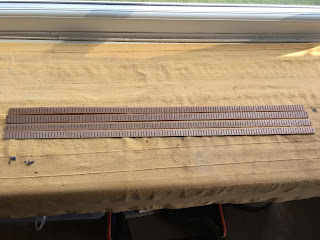Final set up! Now it’s time to turn those big lumps of Corian into a nut and bridge and set the height of the strings.
I installed the tuners permanently and added my label to the inside alongside Faith's!
Then, after marking out the string spacing, I lightly filed slots in the nut and bridge to locate the strings - you really need to use specific slotting files for this to get it right.These are horifically expensive, but I couldn't think of a reliable way to get around using them.
At this point I dropped the nut blank and chipped a corner off it so had to start again. It’s quite brittle stuff this Corian.
I fitted the strings - very exciting - and roughly tuned to get the right tension on the neck, then adjusted the truss rod to correct the small bow.
To set up the nut, the process for each pair of strings is: slacken off strings; remove from slot; file slot a little deeper; reinstate and retension; check height by fretting at 2nd fret and measuring clearance under first fret; repeat until there is barely a paper thickness of clearance.
Once all the slots were done, I shaped the top and sides to be nicely rounded and rubbed down with progressively finer emery paper to get smooth. Then I used a couple of blobs of super glue to locate the nut against the top of the fretboard.
Moving on to the saddle, this is a much more complex shape to form. The point where the string pairs make contact needs to be different depending on what note the string is tuned to, to allow for the slight change in pitch as the string length changes when it is pushed down against a fret. This is called the intonation, for newcomers!
I had a pattern to work against from the book but also checked this by using a piece of cut off string in the appropriate place between the string and saddle. I think it’s actually still not 100% perfect, because I’m having to work around the existing guitar bridge, but it is close enough for my amateur ears!
This is also the point at which the action is adjusted - i.e. the height of the strings above the 12th fret. Fortunately, it was just about perfect, but I could have reduced the height of the saddle a little to correct if necessary.
Then it was a case of detensioning the strings yet again (to remove the saddle) and carefully filing the saddle to shape, then polishing up with emery as for the nut.
The last job was to screw-in the little cover over the truss rod adjuster. And that, my friends, is that!
I’ll try and post a video of what it actually sounds like in a following post but, after having had a half hour initial play, I’m really pleased with how it’s turned out.




















































